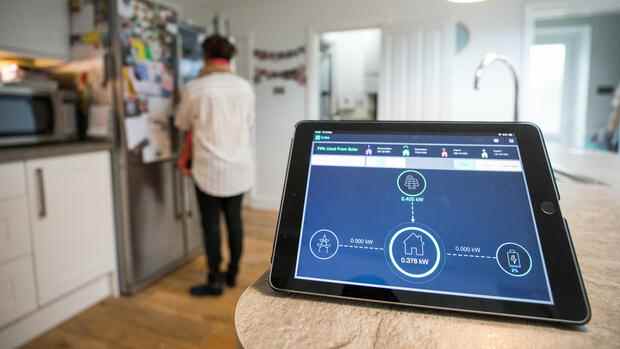Dusseldorf It sounds good in advertising: the heating control reduces energy consumption, the security camera sends pictures of unexpected visitors to the smartphone, the light shines brightly or cozily, depending on requirements. In reality, however, many consumers find digital home technology so confusing that they choose not to equip their homes with it.
However, that could change in the coming months. A new standard called Matter promises to simplify setup and networking. The first products should be available from autumn – the first examples can be seen at the Ifa electronics trade fair in Berlin, which ends on Tuesday.
The industry is optimistic, Amazon speaks of an “important innovation”, Google even of a “new era”. Experts also see an opportunity for a fresh start: “Matter has the potential to become a game changer in the smart home industry,” says Bernd Kotschi, founder of the strategy consultancy Kotschi Consulting. The standard could “contribute significantly to clearing the buying barriers for customers”.
However, consumers have to be patient: the certification of the first devices is taking a long time, the Matter logo with the three arrows is not likely to be widely seen on the packaging until next year – so there is proof that home networking is actually becoming easier still out.
Top jobs of the day
Find the best jobs now and
be notified by email.
So far, the smart home has been a confusing affair: Manufacturers use standards such as WLAN, Bluetooth, Z-Wave or Zigbee. The packs feature the logos of systems such as Alexa, Homekit and Google Assistant. And controlling it requires a large number of its own apps.
Among consumers, complexity is one of the most frequently cited reasons for deciding against a smart home. In a survey by the IT association Bitkom, 28 percent of previous non-users said that the operation seemed too complicated to them – only security and data protection concerns play a greater role.
Rivals get together
Now, with Matter, there is a new attempt to establish a universal language. This is a connection standard that products from different manufacturers can use to communicate with each other over the local network – even if there are problems with the Internet connection.
Individual devices are to become networks. For example, one manufacturer’s door or window sensor can send data to another’s thermostat – and thus cause the heating to be turned down when the room is ventilated. So far, this may have been possible via programming interfaces, but it was very cumbersome.
The decisive difference to previous standards and protocols for the smart home: Matter is supported by around 270 companies, including the major platform operators Amazon, Apple, Alphabet and Samsung, well-known brands such as Ikea, Miele and Sonos, as well as specialists such as Assa-Abloy, Busch- Jaeger and Viessmann.
>> Read about this: Record prices for electricity? This start-up wants to lower the bill
The collaboration between the rivals, who have been tinkering with their own technologies for years, should result from a simple insight. “The entire industry is aware that the smart home has not yet reached its potential,” says Jon Harros of the Connectivity Standards Alliance (CSA), which is leading the standardization process.
The great hope: If Matter ensures that the smart home gains popularity in the mass market, then everyone in the industry will benefit. Also and especially the big platforms.
Harros also argues that standardization makes development work easier. “When it comes to enabling technology, it’s not worth competing – the big companies all offer special functions through their apps that differentiate them.”
More choice, lower prices
The new standard could stimulate the market. So far, manufacturers have had to certify their products for several ecosystems if they want to reach all consumers – such as Apple’s Homekit and Amazon’s Alexa. This considerable effort will be eliminated with the new standard. At the same time, other technical parameters will be standardized.
This has two effects: companies like Tado, Eve or Signify, which have been on the market for years, can more easily certify their products for multiple ecosystems. In addition, according to smart home expert Kotschi: “Due to the low hurdles, a large number of new providers are likely to enter the market. That will fuel the competition.”
The result: there are more products, more choice – and therefore lower prices than today.
At the same time, Matter makes marketing easier for electronics retailers, both online and offline. Instead of having to explain the different systems with their own logos, companies can simply put together bundles of different products. An advantage in advertising, emphasizes Kotschi: “Retailers can be much more aggressive in marketing applications and solutions.”
Eve shows an example of how it can work. The Munich electronics manufacturer, which specializes in the smart home, wants to retrofit 14 devices via software updates, starting in the fall. Products that could previously only be controlled with Apple devices can now also be addressed with Alexa or the Google Assistant.
Electrical associations rely on smart home solutions
However, it may be some time before the entire industry follows suit. The CSA had to postpone the start several times – the development of a standard is complex, emphasizes board member Harros: “The companies have to agree on every part of the specification.” The work is progressing quickly.
The manager, who is involved in the process as director for certification and testing programs, reports that 50 companies are currently in the process of testing their products. He assumes that the first devices will be available in the Christmas business, significantly more in the coming year.
In addition, standardization is not complete in all categories. Working groups have already laid the foundations for controlling lamps, air conditioning, televisions and sensors, but not for security cameras, for example. The start of the new era still needs some time.
More: Inflation and energy crisis – the electronics industry relies on thrift at the Ifa
